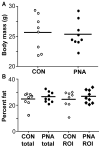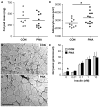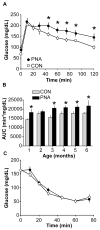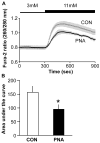Prenatal androgen exposure programs metabolic dysfunction in female mice
- PMID: 20713501
- PMCID: PMC3612271
- DOI: 10.1677/JOE-10-0217
Prenatal androgen exposure programs metabolic dysfunction in female mice
Abstract
Polycystic ovary syndrome (PCOS) is a common fertility disorder with metabolic sequelae. Our laboratory previously characterized reproductive phenotypes in a prenatally androgenized (PNA) mouse model for PCOS. PNA mice exhibited elevated testosterone and LH levels, irregular estrous cycles, and neuroendocrine abnormalities suggesting increased central drive to the reproductive system. In this study, we examined metabolic characteristics of female PNA mice. PNA mice exhibited increased fasting glucose and impaired glucose tolerance (IGT) that were independent of age and were not associated with changes in body composition or peripheral insulin sensitivity. IGT was associated with defects in pancreatic islet function leading to an impaired response to high glucose, consistent with impaired insulin secretion. Exposure of isolated pancreatic islets to androgen in vitro demonstrated an impaired response to glucose stimulation similar to that in PNA mice, suggesting androgens may have activational in addition to organizational effects on pancreatic islet function. PNA mice also exhibited increased size of visceral adipocytes, suggesting androgen-programed differences in adipocyte differentiation and/or function. These studies demonstrate that in addition to causing reproductive axis abnormalities, in utero androgen exposure can induce long-term metabolic alterations in female mice.
Conflict of interest statement
Figures





Similar articles
-
Prenatal androgen excess programs metabolic derangements in pubertal female rats.J Endocrinol. 2013 Mar 19;217(1):119-29. doi: 10.1530/JOE-12-0577. Print 2013 Apr. J Endocrinol. 2013. PMID: 23426873
-
Prenatal androgens alter GABAergic drive to gonadotropin-releasing hormone neurons: implications for a common fertility disorder.Proc Natl Acad Sci U S A. 2004 May 4;101(18):7129-34. doi: 10.1073/pnas.0308058101. Epub 2004 Apr 19. Proc Natl Acad Sci U S A. 2004. PMID: 15096602 Free PMC article.
-
Voluntary Exercise Improves Estrous Cyclicity in Prenatally Androgenized Female Mice Despite Programming Decreased Voluntary Exercise: Implications for Polycystic Ovary Syndrome (PCOS).Endocrinology. 2015 Dec;156(12):4618-28. doi: 10.1210/en.2015-1593. Epub 2015 Sep 10. Endocrinology. 2015. PMID: 26360506 Free PMC article.
-
AMERICAN ASSOCIATION OF CLINICAL ENDOCRINOLOGISTS, AMERICAN COLLEGE OF ENDOCRINOLOGY, AND ANDROGEN EXCESS AND PCOS SOCIETY DISEASE STATE CLINICAL REVIEW: GUIDE TO THE BEST PRACTICES IN THE EVALUATION AND TREATMENT OF POLYCYSTIC OVARY SYNDROME - PART 2.Endocr Pract. 2015 Dec;21(12):1415-26. doi: 10.4158/EP15748.DSCPT2. Endocr Pract. 2015. PMID: 26642102 Review.
-
Androgens and polycystic ovary syndrome.Curr Opin Endocrinol Diabetes Obes. 2009 Jun;16(3):224-31. doi: 10.1097/MED.0b013e32832afd4d. Curr Opin Endocrinol Diabetes Obes. 2009. PMID: 19390322 Review.
Cited by
-
Deletion of Rab GAP AS160 modifies glucose uptake and GLUT4 translocation in primary skeletal muscles and adipocytes and impairs glucose homeostasis.Am J Physiol Endocrinol Metab. 2012 Nov 15;303(10):E1273-86. doi: 10.1152/ajpendo.00316.2012. Epub 2012 Sep 25. Am J Physiol Endocrinol Metab. 2012. PMID: 23011063 Free PMC article.
-
Antiandrogen Treatment Ameliorates Reproductive and Metabolic Phenotypes in the Letrozole-Induced Mouse Model of PCOS.Endocrinology. 2018 Apr 1;159(4):1734-1747. doi: 10.1210/en.2017-03218. Endocrinology. 2018. PMID: 29471436 Free PMC article.
-
Chemogenetic Suppression of GnRH Neurons during Pubertal Development Can Alter Adult GnRH Neuron Firing Rate and Reproductive Parameters in Female Mice.eNeuro. 2020 Jun 22;7(3):ENEURO.0223-20.2020. doi: 10.1523/ENEURO.0223-20.2020. Print 2020 May/Jun. eNeuro. 2020. PMID: 32513661 Free PMC article.
-
The time of prenatal androgen exposure affects development of polycystic ovary syndrome-like phenotype in adulthood in female rats.Int J Endocrinol Metab. 2014 Apr 1;12(2):e16502. doi: 10.5812/ijem.16502. eCollection 2014 Apr. Int J Endocrinol Metab. 2014. PMID: 24910644 Free PMC article.
-
The effect of androgen excess on maternal metabolism, placental function and fetal growth in obese dams.Sci Rep. 2017 Aug 14;7(1):8066. doi: 10.1038/s41598-017-08559-w. Sci Rep. 2017. PMID: 28808352 Free PMC article.
References
-
- Abbott DH, Barnett DK, Bruns CM, Dumesic DA. Androgen excess fetal programming of female reproduction: a developmental aetiology for polycystic ovary syndrome? Hum Reprod Update. 2005;11:357–374. - PubMed
-
- Amiel SA, Sherwin RS, Simonson DC, Lauritano AA, Tamborlane WV. Impaired insulin action in puberty. A contributing factor to poor glycemic control in adolescents with diabetes. N Engl J Med. 1986;315:215–219. - PubMed
-
- Arnold AP, Breedlove SM. Organizational and activational effects of sex steroids on brain and behavior: a reanalysis. Horm Behav. 1985;19:469–498. - PubMed
-
- Blouin K, Veilleux A, Luu-The V, Tchernof A. Androgen metabolism in adipose tissue: recent advances. Mol Cell Endocrinol. 2009;301:97–103. - PubMed
-
- Bock G, Chittilapilly E, Basu R, Toffolo G, Cobelli C, Chandramouli V, Landau BR, Rizza R. Contribution of hepatic and extrahepatic insulin resistance to the pathogenesis of impaired fasting glucose: role of increased rates of gluconeogenesis. Diabetes. 2007;56:1703–1711. - PubMed
Publication types
MeSH terms
Substances
Grants and funding
LinkOut - more resources
Full Text Sources
Other Literature Sources
Medical

